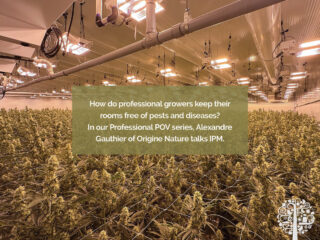IPM: Professional POV with Alex Gauthier, Origine Nature
Award-winning Cannabis Cultivator from Montreal
Alexandre Gauthier started growing cannabis as a teen in the 2000s, lived in Europe for a chunk of those formative years, and began working as the Master Grower for Origine Nature in 2020.
He quickly moved up to Director of Cultivation, and in 2022, Alex became the Vice President of Research, Development and Solutions Engineering for the Licensed Producer (LP). He is a world-renowned cannabis expert and well-respected in the community. Here’s his take on Integrated Pest Management (IPM).
Watch the full interview above, but if you would like the 5 main takeaways, read on!


1. What systems do you have in place for Integrated Pest Management at Origine Nature?
AG: An outbreak, whether it’s pests or mold, will cause financial repercussions, can damage the brand and the supply, and have long-lasting effects.
Our IPM strategy is zero tolerance. We’re a full indoor facility – we are not a greenhouse, we’re not outdoor. So that helps a lot with mitigating the risk. The goal is simply not to introduce anything to where we’re cultivating. Our main strategy is basically perfect training and SOPs for every team member who [enters] the production zone.
Anybody that goes into Origine, especially full-time team members, changes their shoes. When you’re about to go into the production zone, you change shoes again and into gowning. Creating a first strong firewall, which is the training and making sure nothing is introduced within the facility, makes a solid foundation for not having any outbreak.
We do not use pesticides. We’re growing indoors; we’re supposed to be in control.
2. How do you monitor for pests, and what is the role of scouting?
AG: Any valuable asset should at least be protected by three firewall levels. The first firewall would be what I just explained. The second firewall is preventative measures, where we introduce natural predator insects to the facility. We do not use pesticides. We’re growing indoors; we’re supposed to be in control.
If you’re using pesticides on your plant for infestation, it’s because your first layer of the firewall doesn’t work. Also, you need to be very careful. You need to understand the life cycle of the insects that you’re introducing. Finally, the third firewall is scouting.
Scouting is not only for IPM, but also for the overall plant health and the good maintenance of the room. You need somebody scouting those rooms every day. There are also key indicators, like using yellow sticky traps to see if insects are there.
3. What is your most valuable lesson learned with IPM?
AG: Knock on wood, we actually only had one insect outbreak ever.
During licensing, there is the introduction moment where people bring in genetics, and it’s when genetics were brought into Origine that they were contaminated.
We did not have a strong enough protocol to quarantine incoming plants, and we learned a lot from that. Any form of plant that we get goes through an extensive two-to-four-week quarantine, no matter what. We segregate them, load them with natural predators, and we take samples and send them for analysis. Once the plant is cleared of everything, then it can be introduced to our mothers.
4. What are the other most common mistakes that you’ve seen in other operations?
AG: Oh, the first firewall, systematically. People completely underestimate how contaminants can come in, how important sanitation is, how important cross-contamination SOPs are, and the overall workflow.
5. As a home grower, what are some of the controls you can implement for IPM?
AG: The biggest problem is people’s excitement. People want to go check their plants every two minutes, and they ignore the cross-contamination protocol.
So, you go outdoors to have your coffee in the garden, even if you have your shoes on, whatever is on your ankles, your jeans, can be introduced to the room.
Cats, dogs, unfortunately, if you have pets and you let them roam in the grow room, it’s going to be very hard to prevent bugs from entering at some point. You can establish a natural predator defense, but any form of spray will kill the natural defenses that you created. There’s an equilibrium.
There are times of the year with a lot less risk (Winter). Also, trap plants are a very good idea!




